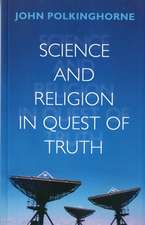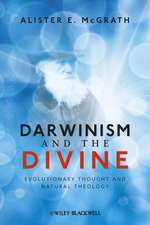A New Science of Religion: Routledge Studies in Religion
Editat de Greg Dawes, James Maclaurinen Limba Engleză Hardback – 24 sep 2012
This volume examines the diversity of new scientific theories of religion, by outlining the logical and causal relationships between these enterprises. Are they truly in competition, as their proponents sometimes suggest, or are they complementary and mutually illuminating accounts of religious belief and practice? Cognitive science has gained much from an interdisciplinary focus on mental function, and this volume explores the benefits that can be gained from a similar approach to the scientific study of religion.
| Toate formatele și edițiile | Preț | Express |
|---|---|---|
| Paperback (1) | 416.22 lei 6-8 săpt. | |
| Taylor & Francis – 31 mai 2017 | 416.22 lei 6-8 săpt. | |
| Hardback (1) | 1055.21 lei 6-8 săpt. | |
| Taylor & Francis – 24 sep 2012 | 1055.21 lei 6-8 săpt. |
Din seria Routledge Studies in Religion
-
 Preț: 349.41 lei
Preț: 349.41 lei -
 Preț: 311.56 lei
Preț: 311.56 lei -
 Preț: 334.83 lei
Preț: 334.83 lei -
 Preț: 311.22 lei
Preț: 311.22 lei -
 Preț: 326.73 lei
Preț: 326.73 lei - 5%
 Preț: 1223.79 lei
Preț: 1223.79 lei -
 Preț: 310.16 lei
Preț: 310.16 lei -
 Preț: 310.03 lei
Preț: 310.03 lei -
 Preț: 311.07 lei
Preț: 311.07 lei -
 Preț: 325.85 lei
Preț: 325.85 lei - 9%
 Preț: 935.67 lei
Preț: 935.67 lei -
 Preț: 325.12 lei
Preț: 325.12 lei -
 Preț: 362.55 lei
Preț: 362.55 lei - 26%
 Preț: 850.54 lei
Preț: 850.54 lei - 26%
 Preț: 819.90 lei
Preț: 819.90 lei -
 Preț: 472.72 lei
Preț: 472.72 lei -
 Preț: 399.23 lei
Preț: 399.23 lei -
 Preț: 482.53 lei
Preț: 482.53 lei -
 Preț: 488.33 lei
Preț: 488.33 lei -
 Preț: 431.57 lei
Preț: 431.57 lei -
 Preț: 369.73 lei
Preț: 369.73 lei - 30%
 Preț: 853.45 lei
Preț: 853.45 lei - 18%
 Preț: 1112.21 lei
Preț: 1112.21 lei - 26%
 Preț: 849.77 lei
Preț: 849.77 lei -
 Preț: 417.81 lei
Preț: 417.81 lei -
 Preț: 485.07 lei
Preț: 485.07 lei - 30%
 Preț: 846.11 lei
Preț: 846.11 lei - 18%
 Preț: 1059.48 lei
Preț: 1059.48 lei -
 Preț: 485.46 lei
Preț: 485.46 lei - 18%
 Preț: 1109.84 lei
Preț: 1109.84 lei - 18%
 Preț: 1113.12 lei
Preț: 1113.12 lei -
 Preț: 486.42 lei
Preț: 486.42 lei - 18%
 Preț: 707.26 lei
Preț: 707.26 lei - 18%
 Preț: 1056.28 lei
Preț: 1056.28 lei - 18%
 Preț: 1003.30 lei
Preț: 1003.30 lei - 25%
 Preț: 823.08 lei
Preț: 823.08 lei -
 Preț: 432.87 lei
Preț: 432.87 lei - 18%
 Preț: 1065.75 lei
Preț: 1065.75 lei -
 Preț: 431.18 lei
Preț: 431.18 lei - 18%
 Preț: 1058.69 lei
Preț: 1058.69 lei
Preț: 1055.21 lei
Preț vechi: 1286.84 lei
-18% Nou
Puncte Express: 1583
Preț estimativ în valută:
201.92€ • 215.92$ • 168.35£
201.92€ • 215.92$ • 168.35£
Carte tipărită la comandă
Livrare economică 17 aprilie-01 mai
Preluare comenzi: 021 569.72.76
Specificații
ISBN-13: 9780415635851
ISBN-10: 0415635853
Pagini: 434
Ilustrații: 8 b/w images
Dimensiuni: 152 x 229 x 14 mm
Greutate: 0.47 kg
Ediția:1
Editura: Taylor & Francis
Colecția Routledge
Seria Routledge Studies in Religion
Locul publicării:Oxford, United Kingdom
ISBN-10: 0415635853
Pagini: 434
Ilustrații: 8 b/w images
Dimensiuni: 152 x 229 x 14 mm
Greutate: 0.47 kg
Ediția:1
Editura: Taylor & Francis
Colecția Routledge
Seria Routledge Studies in Religion
Locul publicării:Oxford, United Kingdom
Public țintă
Postgraduate and UndergraduateCuprins
Introduction Gregory Dawes and James Maclaurin Part I: The Study of Religion 1. What is Religion? Gregory Dawes and James Maclaurin 2. Evolutionary Religion Studies: Notes on a Unified Science of Religion Todd Tremlin 3. Explaining Effervescence Joseph Bulbulia and Paul Reddish 4. Implicit Measures in the Experimental Psychology of Religion Jonathan Jong Part II: Explanatory Strategies 5. Explaining Ritual Harvey Whitehouse 6. Ecological Signalling Joseph Bulbulia, Marcus Frean, and Paul Reddish 7. Thinking about Religion: Examining Progress in Religious Cognition Aaron C.T. Smith and Howard Sankey Part III: Philosophical Implications 8. Evolutionary Debunking Arguments in Three Domains: Fact, Value, and Religion John S. Wilkins and Paul E. Griffiths 9. Subversive Explanations Charles R. Pigden 10. Do Naturalistic Explanations of Religious Beliefs Debunk Religion? Robert Nola 11. The Rationality of Heuristic Religious Belief Graham Wood Notes on Contributors Notes Index
Descriere
There are contrasting theories that deal with different aspects of human religiosity – some focus on religious beliefs, while others focus on religious actions, and still others on the origin of religious ideas. While these theories might share a similar focus, there is plenty of disagreement in the explanations they offer. This volume examines the diversity of new scientific theories of religion, by outlining the logical and causal relationships between these enterprises. Are they truly in competition, as their proponents sometimes suggest, or are they complementary and mutually illuminating accounts of religious belief and practice?













